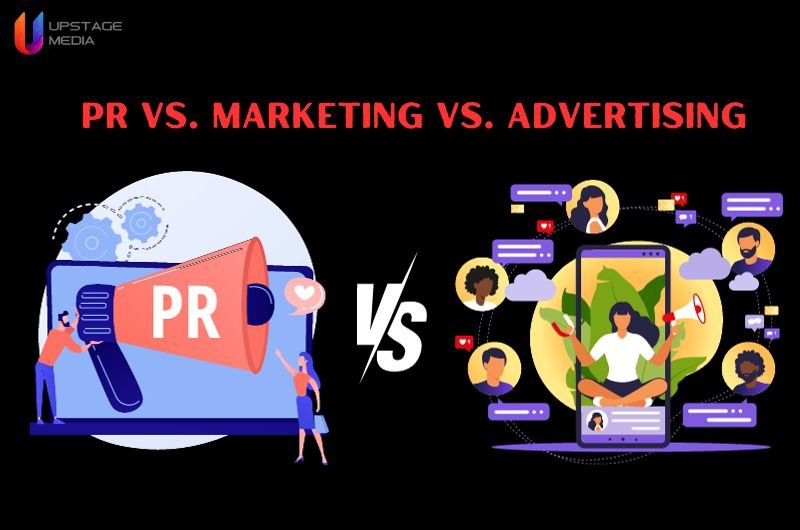Table of Contents
Recently updated on September 4th, 2024
Public Relations (PR), Marketing, and Advertising are distinct yet interconnected components of the vast landscape of communication and business promotion. Each of them uniquely plays an important role in shaping how individuals and organizations are perceived, intensifying customers’ behavior, and achieving the overall business objectives.
Definition of Public Relations (PR)
Public Relations (PR) is a strategic communication process that builds and maintains a positive relationship between an organization and its public. It involves managing the spread of information between businesses or an organization and the public. PR aims to create and maintain a positive image, reputation, and understanding of the organization with the target audience.
In brief, PR focuses on fostering goodwill and trust, often through channels such as community engagement, media, and crisis management. It’s about giving shape to a brand, addressing public concerns, and intensifying a positive perception.
Definition of marketing
Marketing is known as the comprehensive business practice that includes communicating, creating, and delivering offers that have value for customers, partners, and society at a very large scale. It is a broader term that encompasses various activities aimed at promoting products, services, or brands to drive sales and achieve business targets. The focus of marketing is to understand and satisfy customers. Marketing involves the coordination of several interrelated and interdependent activities. Marketing creates utilities of time, place, and position through storage, transportation, and sale of products.

Marketing strategies include market research, product development, Pricing, promotion, and distribution. The goal is to understand customer needs and preferences, create products that meet those needs, and effectively communicate the value proposition to the target audience. Marketing is needed not only in business.
In non-business organizations also marketing is needed for spreading socially useful ideas like family planning hygiene, communal harmony immunization, blood donation, environment protection, patriotism, etc. Marketing involves a mix of elements, known as the 4 P’s. The 4 P’s include Product, Price, Place, and Promotion.
Functions of Marketing
The specialized activities that are required to be performed in the marketing of goods and services are called marketing functions. Some of the marketing functions are mentioned below:
- Buying and Assembling:
Buying is the first step in the process of marketing. Buying means the procurement of raw materials components and finished goods. Efficient and economical buying is essential for success in marketing. “Goods well bought are half sold”.
- Selling and Distribution:
Selling is the heart of marketing. ‘Nothing happens until somebody sells something’. The purpose of all marketing activities is to sell the goods or services. Selling enables a firm to satisfy the needs of customers and thereby achieve its objectives. Selling is the process of finding customers, creating demand, and transferring the goods for value or money.
- Transportation:
Transportation is the physical means of carrying goods from one place to another. It plays a vital role in marketing. It serves as a link between the producers and the consumers who are located in different places.
- Storage and Warehousing:
Storage refers to the preservation of goods from the time of production till the time of consumption. It is a very important function of marketing and some amount of goods are stored at every step in the marketing process. Storage creates time you treat tea by bridging the time gap between production and consumption.
- Product Planning and Development:
Products are the base of marketing because all marketing functions revolve around products. The success of the marketing department depends upon the degree to which the products offer satisfaction to the needs of customers. This function involves a decision as to what products to produce or purchase for sale. The design, color, size, quality, and other features of the product should be decided keeping in view the needs and desires of customers.
- Branding and labeling:
Branding is the process of assigning a distinctive brand name or symbol to a product to differentiate it from competitive products. Branding helps to give a separate identity to the product. It facilitates advertising and price control.
- Pricing:
Pricing refers to the process of fixing the price of a product or service. It is an important function in marketing because it determines the sales volume and the amount of profit.
- Salesmanship:
Informing and persuading prospective customers is essential for successful marketing in this competitive world. Salesmanship is the process of creating demand through personal contact between the buyer and the seller. It eliminates the gap between the products and the consumer which further helps in providing useful feedback from the consumer side.
Definition of Advertising
Advertising is the process of making the form and its products known to people in such a manner that a desire to buy the product is created in them. Advertising helps in retaining existing customers and attract new customers. It educates people and persuades them to buy a product or service.
Advertising is a specific component of the marketing mix, focusing on paid promotional efforts to reach and persuade a target audience. It involves creating and placing messages, often through various media channels, to promote products, services, or ideas. Advertising is a paid form of communication, and it can take many forms including print, broadcast, digital, outdoor, and more. Advertising is done through several media, e.g., newspapers, magazines, radio television, cinema, posters, etc.

Advertising helps to widen the markets and to increase sales. It is very useful for introducing new products and new uses of the existing products. The primary objective of advertising is to generate awareness, create interest, and ultimately drive sales. It often employs creative elements to capture attention and leave a lasting impression on the audience. Advertising wings the confidence of customers and eliminates seasonal fluctuations.
The difference between PR, marketing, and advertising
The table mentioned below table shows the brief distinction between Public Relations (PR), marketing, and advertising:
| Basis of Distinction | Public Relations (PR) | Marketing | Advertising |
| Purpose | Build and maintain relationships with the Public | Promote products and services | Create awareness and persuade customers to make a purchase |
| Focus | Reputation management, enhancing goodwill, and maintaining a positive image | Customer satisfaction and market research | Creating compelling messages to promote products and services |
| Communication | Two-way communication | One-way communication | One-way Communication |
| Audience | Wide range of stakeholders including media, the public, and employees | Target market segments | Specific Target audience |
| Timing | Continuous ongoing long-term relationships | Aligns with Marketing strategy and product life cycle | Campaign-based with specific start |
| Control | Limited Control | More control over marketing strategies | High control over the content and message presented |
| Channels | Media relations, social media, and community engagement | Digital marketing, traditional advertising, promotions, and sales | TV, radio, print, online, cinema, and various other media platforms |
Comparison of activities
The tasks that PR teams, Advertising teams, and marketing teams are responsible for differ uniquely. This further involves the functions of each department, the metrics used, and the target audience.
| Basis of Comparison | Public Relation | Marketing | Advertising |
| Objectives | Establishing good relationships with the company’s stakeholders and customers Positive image creation | Attracting new customers Generating Profits | Communicating the benefits of products Customer Acquisition |
| Daily Routine | Writing a Press Release Investor relations | Fulfillment Planning with manufacturing teams Reviewing Customers Feedback | Purchasing advertising space on online platforms, or TV’s Budgeting for the media campaign |
| Target Audience | CustomersEmployeesInvestors | New as well as existing customersSuppliersShareholders | New customers as well as existing one |
| Metrics | Social EngagementDomain Authority | Share Price RevenueBrand awareness | Brand awarenessConversion ratesTrafficCustomer engagement |
| Impact on Brand | Building the Brand Through Positioning | Creating the brand base | Using the brand assets |
How PR success is measured
Depending upon the Public Relations, or the marketing campaign’s goal, distinct KPIs are getting involved in measuring the success of activities. There is a requirement for something tangible to show how Marketing and Public relations efforts contribute to the company’s ROI and Profit results. KPIs prepare goals more realistic and demonstrate how investment in PR supports the overall company objective.
- Earned Traffic
This is the number of visitors that are driven to the company website as a result of receiving links. This Earned traffic is distinct from traffic gained through advertising.
- Domain Authority
Domino authority is measured by using tools like Semrush. Bisecuring links on third-party websites, PR contributes to how well the website ranks on Search Engines.
- Outreach Media
One of the matrices that the PR team is measured against is the count of press releases and pitches the PR team has sent and how they perform after getting published.

How marketing success is measured
Marketing Metrics are aligned a much more with organizational strategic objectives:
- Share Price
If the company is public then the price of the share will be of primary concern. This is highly aligned with shareholders’ perception, managed by the PR team.
- Gross Profit and Revenue
Gross profit and revenue will also come up as the key metrics for the whole marketing team and the entire business.
How advertising success is measured
Advertising KPIs vary, depending upon the type of advertising the company is processing. Here are some of the ways mentioned below to measure the advertising success rate:
- Click-Through Rate (CTR) Metrics
CTR is a marketing metric that represents the metrics of the percentage of email recipients who click on a link and visit the main page of purchase through an email. A low click-through rate means you just need to emphasize some more simple strategies that improve CTR. It’s a direct indicator of engagement and content strategy.
Driving traffic and turning it into revenue requires knowing which links connect with your audience. While creating an email, there are a few strategies to improve click-through rates. For instance, include links strategically throughout the email and provide a call to action button that subscribers may use to effortlessly redeem the offer. It has been observed that open rates are often higher than click-through rates.
- Conversion Rate Metrics
The conversion rate shows how many people clicked on the links and then completed a particular action. CTR is the next general metric that can truly help you in analyzing how well your campaigns are running. For example: if you have included a link in your email for your subscribers to grab a position in Tuesday’s sale. The conversion rate will let you know how many people clicked the link and made a final purchase.
The conversion rate shows the number of receivers who completed the desired action, like making a purchase. Through conversion rates, you can easily earn a high return on investment. When you generally know how much you have spent and how many subscribers are converting, it’s best to know whether the money used in the campaign has been well received or not.
- Social Engagement metrics
Measuring social interaction ensures that you can evaluate the success of your social media strategy and identify areas for development. They serve as bonus points for your online interactions and postings, letting you know which of your posts were liked, shared, and commented on.
This overall engages engagement. Social media metrics find out how frequently they interact with your materials. This data further gives two crucial aspects: The first one is audience enrollment. The second one is social media algorithms that assist widely in reaching a wider audience.
- ROI Metrics
ROI metrics should be tracked by every marketer. It shows the overall return on investment for your campaigns. You can easily calculate this by considering the money you made in sales minus the money you spent to execute the campaign then dividing that money invested in the campaign and then multiplying it by 100.

This serves as the most basic and effective formula to serve and find ROI. In 2023, optimizing ROI is a top priority, given the focus on cost efficiency. Any marketing success may require a high investment but also gives the highest ROI out of any marketing strategy. This type of metric helps you show your boss and your sales team the importance of advertising as a result that generates true results.
Overlaps and similarities
Overall PR, marketing, and advertising are different from one another. Because all assist brands and communicate with target audiences. They truly help in establishing a brand’s identity and voice. This requires the marketing department and PR team to work together on the demands of target audiences.
- Public Relations (PR)
PR is highly concerned with reputation management. The activities set out to establish the market power of the brand.
- Marketing
Marketing holds all the product strategy, sales promotion, and pricing together. In this sense, marketing shows the combined efforts that create awareness, drive profit, and acquire customers.
- Advertising
In usual time advertising messages are compiled by a specific call-to-action process.
Conclusion
In conclusion, while PR is about managing relationships and building reputation, marketing encompasses a broader set of activities to deliver value to customers, and advertising specifically focuses on paid promotional efforts to reach and persuade a target audience. These three disciplines work together synergistically to achieve overall business objectives.
However, Upstage Media comes up as the No.1 PR Agency that helps business owners and entrepreneurs get PR and become the best authority in their niche. The team of experts is highly experienced and has a great knowledge of digital PR or say digital media. With 4+ years of experience, we are here to help brands and businesses in expanding their online media presence.
